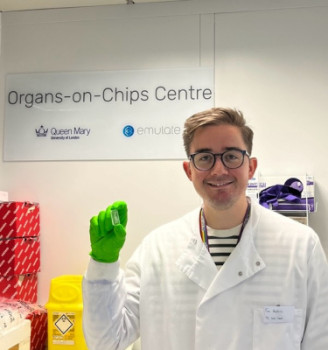News
New organ-on-a-chip model of human synovium could accelerate development of treatments for arthritis
16 October 2023
Researchers at the Centre for Predictive in vitro Models at Queen Mary University of London have developed a new organ-on-a-chip model of the human synovium, a membrane-like tissue that lines the joints. The model, published in the journal Biomedical Materials, could help researchers better understand the mechanisms of arthritis and develop new treatments for this group of debilitating diseases.
In the UK, more than 10 million people live with a form of arthritis, which affects the joints and can cause pain, stiffness, and swelling. There is currently no cure for arthritis and the search for new therapeutics is limited by a lack of accurate models.
The new synovium-on-a-chip model is a three-dimensional microfluidic device that contains human synovial cells and blood vessel cells. The device is subjected to mechanical loading, which mimics the forces applied to the synovium during joint movement.
The developed synovium-on-a-chip model was able to mimic the behaviour of native human synovium, producing key synovial fluid components and responding to inflammation. This suggests that the new platform has immense potential to help researchers understand disease mechanisms and identify and test new therapies for arthritic diseases.
"Our model is the first human, vascularised, synovium-on-a-chip model with applied mechanical loading and successfully replicates a number of key features of native synovium biology," said Dr Timothy Hopkins, Versus Arthritis Foundation Fellow and joint lead author of the study. "The model was developed upon a commercially available platform (Emulate Inc.), that allows for widespread adoption without the need for specialist knowledge of chip fabrication. The vascularised synovium-on-a-chip can act as a foundational model for academic research, with which fundamental questions can be addressed, and complexity (further cell and tissue types) can be added. In addition, we envisage that our model could eventually form part of the drug discovery pipeline in an industrial setting. Some of these conversations have already commenced."
The researchers are currently using the synovium-on-a-chip model to study the disease mechanisms of arthritis and to develop stratified and personalized organ-on-a-chip models of human synovium and associated tissues.
"We believe that our synovium-on-a-chip model, and related models of human joints currently under development in our lab, have the potential to transform pre-clinical testing, streamlining delivery of new therapeutics for treatment of arthritis," Professor Martin Knight, Professor of Mechanobiology said. "We are excited to share this model with the scientific community and to work with industry partners to bring new treatments to patients as quickly as possible."
Email: m.m.knight@qmul.ac.uk
Link: https://www.cpm.qmul.ac.uk/people/mknight#research
Updated by: Martin Knight



